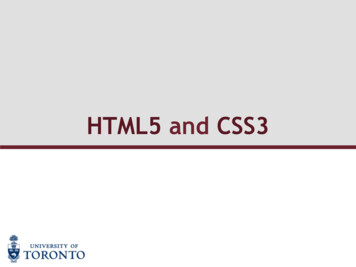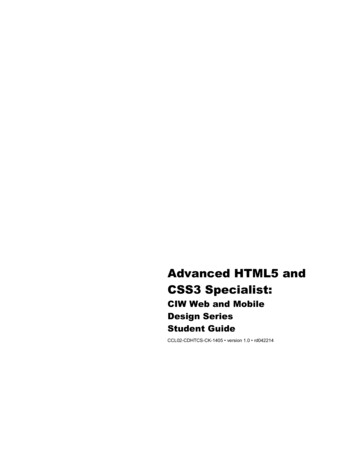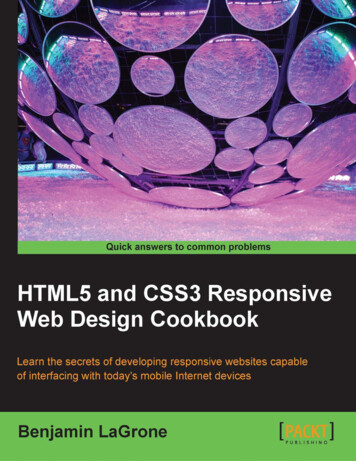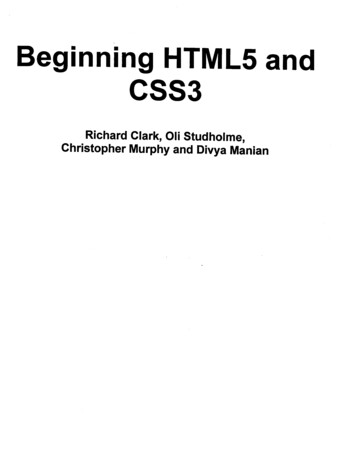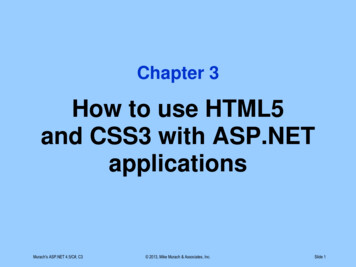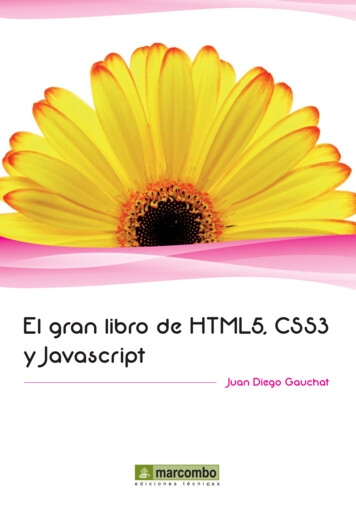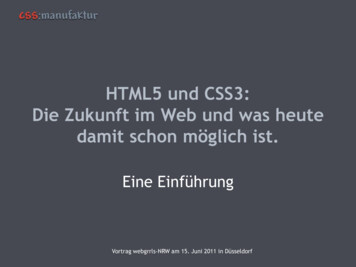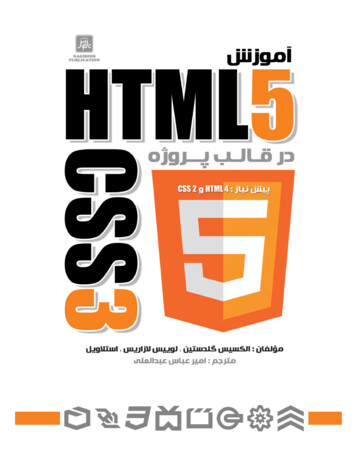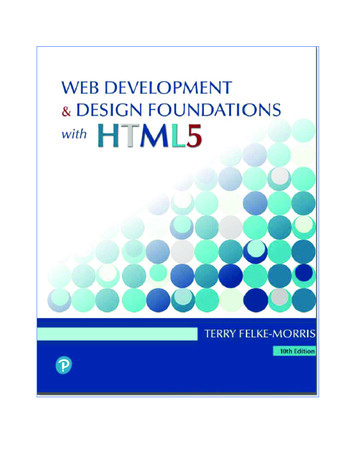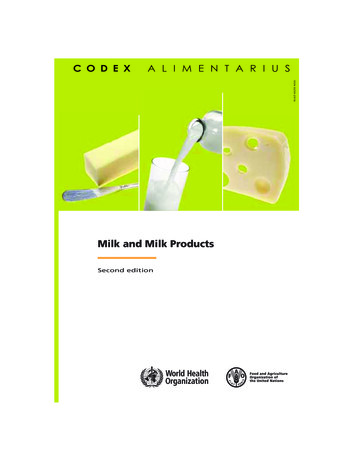
Transcription
Extracted from:HTML5 and CSS3, Second EditionLevel Up with Today’s Web TechnologiesThis PDF file contains pages extracted from HTML5 and CSS3, Second Edition,published by the Pragmatic Bookshelf. For more information or to purchase apaperback or PDF copy, please visit http://www.pragprog.com.Note: This extract contains some colored text (particularly in code listing). Thisis available only in online versions of the books. The printed versions are blackand white. Pagination might vary between the online and printed versions; thecontent is otherwise identical.Copyright 2013 The Pragmatic Programmers, LLC.All rights reserved.No part of this publication may be reproduced, stored in a retrieval system, or transmitted,in any form, or by any means, electronic, mechanical, photocopying, recording, or otherwise,without the prior consent of the publisher.The Pragmatic BookshelfDallas, Texas Raleigh, North Carolina
Many of the designations used by manufacturers and sellers to distinguish their productsare claimed as trademarks. Where those designations appear in this book, and The PragmaticProgrammers, LLC was aware of a trademark claim, the designations have been printed ininitial capital letters or in all capitals. The Pragmatic Starter Kit, The Pragmatic Programmer,Pragmatic Programming, Pragmatic Bookshelf, PragProg and the linking g device are trademarks of The Pragmatic Programmers, LLC.Every precaution was taken in the preparation of this book. However, the publisher assumesno responsibility for errors or omissions, or for damages that may result from the use ofinformation (including program listings) contained herein.Our Pragmatic courses, workshops, and other products can help you and your team createbetter software and have more fun. For more information, as well as the latest Pragmatictitles, please visit us at http://pragprog.com.The team that produced this book includes:Susannah Davidson Pfalzer (editor)Potomac Indexing, LLC (indexer)Candace Cunningham (copyeditor)David J Kelly (typesetter)Janet Furlow (producer)Juliet Benda (rights)Ellie Callahan (support)Copyright 2013 The Pragmatic Programmers, LLC.All rights reserved.No part of this publication may be reproduced, stored in a retrieval system, ortransmitted, in any form, or by any means, electronic, mechanical, photocopying,recording, or otherwise, without the prior consent of the publisher.Printed in the United States of America.ISBN-13: 978-1-937785-59-8Encoded using the finest acid-free high-entropy binary digits.Book version: P1.0—October 2013
PrefaceTo a web developer, three months on the Web is like a year in real time. Andthat means it’s been twelve web years since the last edition of this book.We web developers are always hearing about something new. A few years agoHTML5 and CSS3 seemed so far off, but companies are using these technologies in their work today because browsers like Chrome, Safari, Firefox, Opera,and Internet Explorer are implementing pieces of the specifications.HTML5 and CSS3 help lay the groundwork for solid, interactive web applications. They let us build sites that are simpler to develop, easier to maintain,and more user-friendly. HTML5 has elements for defining site structure andembedding content, which means we don’t have to resort to extra attributes,markup, or plug-ins. CSS3 provides advanced selectors, graphicalenhancements, and better font support that makes our sites more visuallyappealing without using font image-replacement techniques, complex JavaScript, or graphics tools. Better accessibility support will improve dynamicJavaScript client-side applications for people with disabilities, and offlinesupport lets us start building working applications that don’t need an Internetconnection.In this book, we’ll get hands-on with HTML5 and CSS3 so you can see howto use them in your projects, even if your users don’t have browsers that cansupport all of these features yet. Before we get started, let’s take a second totalk about HTML5 and buzzwords.HTML5: The Platform vs. The SpecificationHTML5 is a specification that describes some new tags and markup, as wellas some wonderful JavaScript application programming interfaces (APIs), butit’s getting caught up in a whirlwind of hype and promises. Unfortunately,HTML5 the standard has evolved into HTML5 the platform, creating an awfullot of confusion among developers and customers. In some cases, pieces fromthe CSS3 specification, such as shadows, gradients, and transformations, Click HERE to purchase this book now. discuss
Preface viare being called HTML. Browser-makers are trying to one-up each other withhow much “HTML5” they support. People are starting to make strange requestslike “Create the site in HTML5.”For the majority of the book, we’ll focus on the HTML5 and CSS3 specificationsthemselves and how you can use the techniques they describe on all thecommon web browsers. In the last part of the book, we’ll look into a suite ofclosely related specifications associated with HTML5 that are in use right nowon multiple platforms, such as Geolocation and Web Sockets. Although thesetechnologies aren’t technically HTML5, they can help you build incrediblethings when combined with HTML5 and CSS3.What’s in This BookEach chapter in this book focuses on a specific group of problems that wecan solve with HTML5 and CSS3. Each chapter has an overview and a listsummarizing the tags, features, or concepts covered in the chapter. The maincontent of each chapter is broken into tips, which introduce you to a specificconcept and walk you through building a simple example using the concept.The chapters in this book are grouped topically. Rather than group thingsinto an HTML5 part and a CSS3 part, it made more sense to group thembased on the problems they solve. You’ll find some chapters that specificallyfocus on CSS3, and you’ll find CSS3 goodness sprinkled throughout otherchapters.Many tips contain a section called “Falling Back,” which shows you methodsfor addressing users whose browsers don’t directly support the feature we’reimplementing. We’ll be using a variety of techniques to make these fallbackswork, from third-party libraries to our own JavaScript and jQuery solutions.Each chapter wraps up with a section called “The Future,” where we discusshow the concept can be applied as it becomes more widely adopted.We’ll start off with a brief overview of HTML5 and CSS3 and take a look atsome of the new structural tags you can use to describe your page content.Then we’ll work with forms, and you’ll get a chance to use some form fieldsand features, such as autofocus and placeholders. From there, you’ll get toplay with CSS3’s new selectors so you can learn how to apply styles to elements without adding extra markup to your content.Then we’ll explore HTML5’s audio and video support, and you’ll learn how touse the canvas to draw shapes. You’ll also see how to use CSS3’s shadows,gradients, and transformations, as well as how to work with fonts, transitions,and animations. Click HERE to purchase this book now. discuss
What’s in This Book viiNext we’ll use HTML5’s client-side features, such as web storage, IndexedDB,and offline support to build client-side applications. We’ll use web sockets totalk to a simple chat service, and discuss how HTML5 makes it possible tosend messages and data across domains. You’ll also get a chance to play withthe Geolocation API and learn how to manipulate the browser’s history.This book focuses on what you can use today in modern browsers. AdditionalHTML5 and CSS3 features might not be ready for widespread use yet but arevaluable nonetheless. You’ll learn more about them in the final chapter,Chapter 11, Where to Go Next, on page ?.In Appendix 1, Features Quick Reference, on page ?, you’ll find a listing ofall the features covered in this book, with a quick reference to the chaptersthat reference each feature. We’ll be using a lot of jQuery in this book, soAppendix 2, jQuery Primer, on page ?, gives you a short primer. Appendix3, Encoding Audio and Video for the Web, on page ?, is a small appendixexplaining how to encode audio and video files for use with HTML5.Browser Compatibility ListsAt the start of each chapter, you’ll find a list of the HTML5 features we’ll discuss. In these lists, browser support is shown in square brackets using ashorthand code and the minimum supported version number. The codes usedare C: Chrome, F: Firefox, S: Safari, IE: Internet Explorer, O: Opera, iOS: iOSdevices with Safari, and A: Android browser.What’s Not in This bookWe won’t talk about Internet Explorer versions before Internet Explorer 8.Microsoft has actively pushed people off of those old browsers.We also won’t cover every aspect of HTML5 and CSS3. Some things don’tmake sense to talk about because the implementations have changed orthey’re not practical yet. For example, the CSS grid layout is really exciting,1but it’s not worth spending time on until browsers all get “on the same page.”In this book I focus on showing how you can use HTML5 and CSS3 techniquesright now to improve things for the widest possible audience.Since this book doesn’t have any basic HTML or CSS content, it’s not a bookfor absolute beginners. It is aimed primarily at web developers who have agood understanding of HTML and CSS. If you’re just getting started, go get acopy of HTML and CSS: Design and Build Websites [Duc11], by Jon Duckett.1.http://www.w3.org/TR/css3-grid-layout/ Click HERE to purchase this book now. discuss
Preface viiiIt covers the basics nicely. You should also look at Designing with WebStandards [Zel09], by Jeffrey Zeldman.I assume that you have a basic understanding of JavaScript and jQuery,2which we’ll be using to implement many of our fallback solutions. Appendix2, jQuery Primer, on page ?, is a brief introduction to jQuery that covers thebasic methods we’ll be using, but you should consider picking up the bookPragmatic Guide to JavaScript [Por10], by Christophe Porteneuve, as a morein-depth reference for JavaScript. The last part of the book gets pretty JavaScript-heavy, but I’m confident you’ll do just fine.Changes in the Second EditionThe second edition of this book brings everything up-to-date and removesmaterial that specifically targets Internet Explorer 7 and lower. You’ll findmore detail on HTML5 accessibility, more stable and proven fallbackapproaches, and nine new tips: Tip 2, Showing Progress toward a Goal with the meter Element, on page ? Tip 4, Defining an FAQ with a Description List, on page ? Tip 8, Validating User Input without JavaScript, on page ? Tip 19, Creating Vector Graphics with SVG, on page ? Tip 22, Making Videos Accessible, on page ? Tip 16, Improving Table Accessibility, on page ? Tip 26, Making Things Move with Transitions and Animations, on page ? Tip 28, Storing Data in a Client-Side Database Using IndexedDB, on page ? Tip 34, Getting It All Sorted Out with Drag and Drop, on page ?Plus, you’ll explore CSS’s Flexible Box model, cross-origin resource sharing,web workers, server-sent events, and CSS filter effects in Chapter 11, Whereto Go Next, on page ?.In addition to the new content, the other tips have been updated with newfallback solutions as necessary, and you’ll find a handy Node.js-based webserver in this book’s example-code download, which will make it easy for youto test all the projects across multiple browsers.2.http://www.jquery.com Click HERE to purchase this book now. discuss
How to Read This Book ixHow to Read This BookDon’t feel that you have to read this book from cover to cover. It’s broken upinto easily digestible tips that focus on one or two core concepts. In eachchapter, you’ll find several projects. If you download the example code fromthis book’s website,3 you’ll find a template/ folder, which is a great place tostart.When you see code examples like thishtml5 new tags/index.html link rel "stylesheet" href "stylesheets/style.css" the label above the code shows where you’ll find the file in the example code. Ifyou’re reading this in electronic format, you can click that label to bring up theentire file so you can see the code in context. The label shows the location of thefile in the example code; it may not always match the file you’re working with.Finally, follow along with the code in the book and don’t be afraid to examineand tweak the finished examples. Let’s get more specific about what you needto work with the examples in this book.What You NeedYou’ll need Firefox 20 or later, Chrome 20 or higher, Opera 10.6, or Safari 6to test the code in this book. You’ll probably want all of these browsers to testeverything we’ll be building, since each browser does things a little differently.Having an Android or iOS device around is helpful, too, but it’s not required.Testing on Internet ExplorerYou’ll also need a way to test your sites with Internet Explorer 8 and later soyou can ensure that the fallback solutions we create actually work. The easiestway to do this is to install Microsoft Windows on VirtualBox for testing.4Microsoft provides free virtual machines for testing web applications atModern.IE, where you can download ready-to-go images for VirtualBox, Parallels, or VMware.5 These machines work for thirty days and then need to beredownloaded.Node.js and the Example ServerTesting some of the features in this book requires that you serve the HTMLand CSS files from a web server, and testing others requires a more p://virtualbox.orghttp://modern.ie Click HERE to purchase this book now. discuss
Preface xback end. In the downloadable example code for the book, you’ll find a serveryou can use to make the examples easier to work with. To run this serveryou’ll need to install Node.js by following the instructions on the Node.jswebsite.6 You’ll want at least version 0.10.0 to avoid intermittent servercrashes.You’ll also need npm, a command-line utility to install
HTML5 and CSS3 seemed so far off, but companies are using these technolo-gies in their work today because browsers like Chrome, Safari, Firefox, Opera, and Internet Explorer are implementing pieces of the specifications. HTML5 and CSS3 help lay the groundwork for solid, interactive web applica-tions. They let us build sites that are simpler to .
